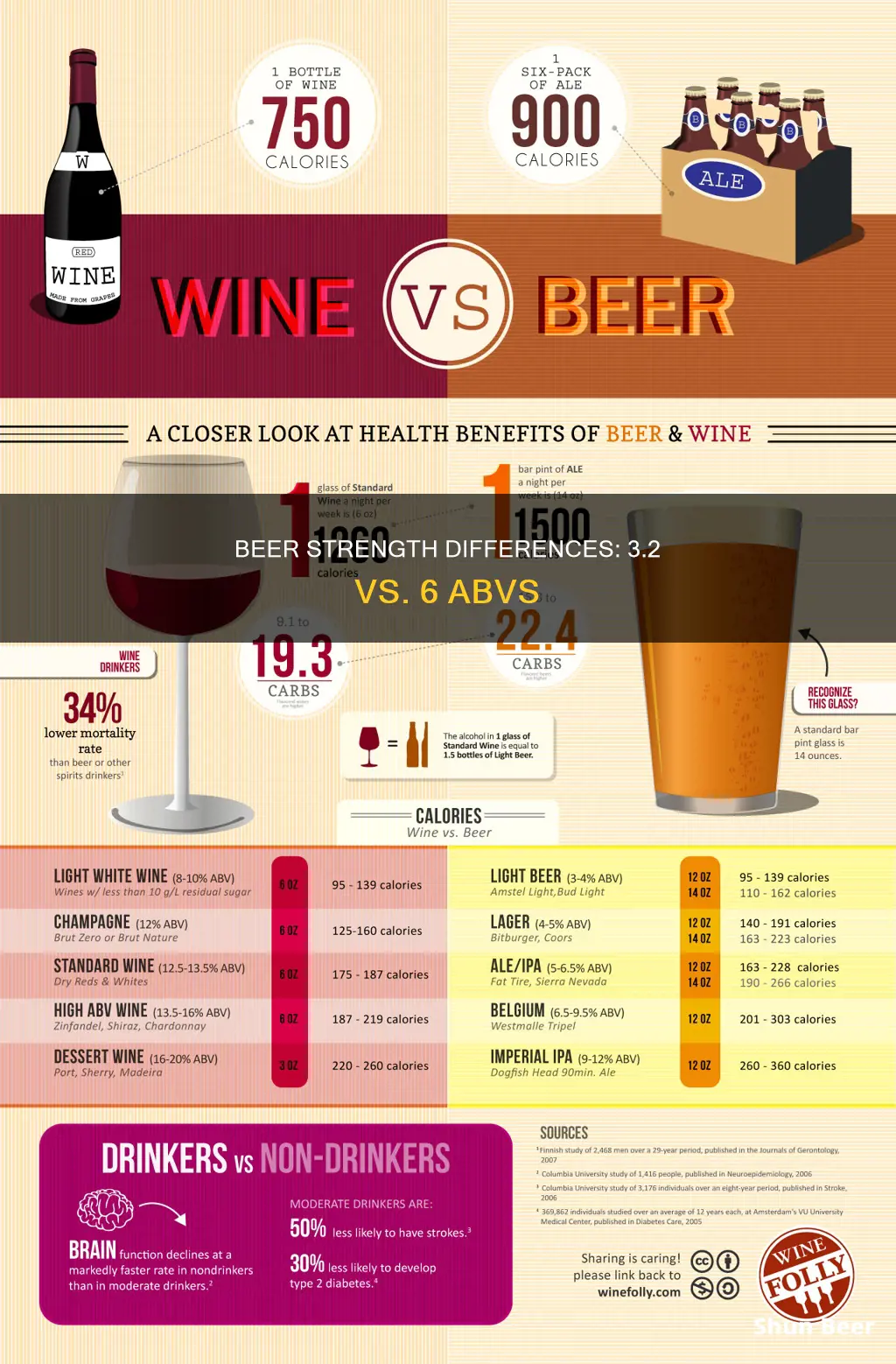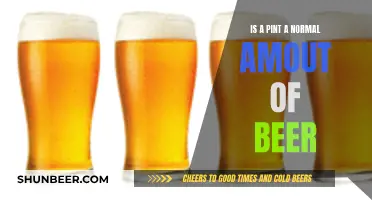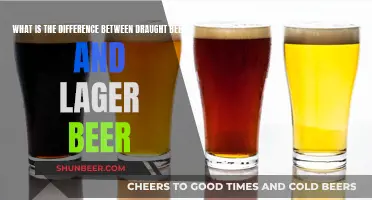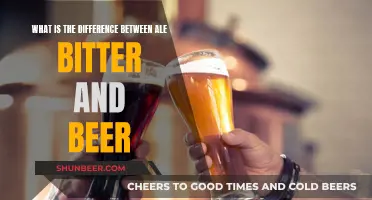
The terms 3.2 beer and 6-point beer refer to beers with different alcohol contents. 3.2 beer, also known as low-point beer, contains 3.2% alcohol by weight or 4% alcohol by volume. On the other hand, 6-point beer is calculated by volume and contains 6% alcohol. The distinction between these two types of beer is important, especially when it comes to purchasing and consuming alcohol in certain states. For example, Oklahoma previously prohibited the sale of beer higher than 3.2% in grocery stores due to its prohibition laws.
What You'll Learn

History of 3.2 beer
2 beer, or "three-two" beer, is a Depression-era relic that has survived due to quirks of history and law, monopolistic interests, and bureaucratic apathy. The term "low-point beer" is unique to the United States, where some states limit the sale of beer. However, beers of this type are also found in countries like Sweden and Finland, which tax or regulate beer according to its alcohol content.
In the United States, 3.2 beer was the highest alcohol content beer that could be legally produced for nine months in 1933. On March 22, 1933, as part of his New Deal, President Franklin D. Roosevelt signed the Cullen–Harrison Act, which repealed the Volstead Act. This Act immediately allowed the sale of beer, but with an extremely specific alcohol content: 3.2% by weight.
The 3.2% limit was a compromise—an arbitrary number with nothing magical about it. Because Prohibition was still officially the law, there had to be a limit on the amount of alcohol in beer. Hearings were held, and the political process worked out this standard, which could gather the necessary votes.
The compromise of 3.2% was based on scientific arguments about intoxication. Yandell Henderson, a Yale physiologist, and Anton Carlson, a University of Chicago physiologist, were influential in determining this limit. Henderson's research methods were questionable, and Carlson declared 3.2% beer "non-intoxicating" based on an extremely high threshold for intoxication.
After the repeal of Prohibition, a number of state laws prohibiting the sale of intoxicating liquors remained in effect. As these were repealed, they were replaced by laws limiting the maximum alcohol content allowed for sale to 3.2% alcohol by weight. As of 2019, Minnesota was the only state that restricted the sale of beer in general establishments such as supermarkets and convenience stores to low-point beer. In recent years, several states, including Colorado, Kansas, Oklahoma, and Utah, have revised their laws to end this practice.
Exploring the Diverse Flavors of Beer: A Tasty Adventure
You may want to see also

Alcohol content
2 beer, also known as "light beer", "low-point beer", or "low-alcohol beer", contains 3.2% alcohol by weight or 4% alcohol by volume. This alcohol percentage is lower than that of regular beers, which usually have an alcohol content of 5% ABV or higher.
The distinction between 3.2 and 6% beer is not as significant as it may seem at first glance. The former is measured by weight, while the latter is calculated by volume. When 6% beer is calculated by weight, it totals 4.7% alcohol, making the difference in alcohol content between the two types of beer around 1.5%.
The lower alcohol content of 3.2 beer means it has a lower calorie density and is cheaper to produce. It is also widely available in most states, being sold in convenience stores, grocery stores, and gas stations.
The history of 3.2 beer dates back to the Prohibition era in the United States. In 1933, Anton J. Carlson, the chairperson of the University of Chicago's Physiology Department, declared 3.2% ABW as the standard of non-intoxication. This led to the creation of 3.2 beer, which was still allowed under Prohibition laws. After Prohibition ended in 1933, 3.2 beer remained popular and was the most consumed beer in the United States until the early 1950s.
Today, 3.2 beer is slowly disappearing from store shelves as consumers demand more craft beer options. As of 2019, only eight states still had 3.2 beer regulations, and as of 2024, Minnesota is the only state left selling 3.2 beer.
Exploring Samuel Adams' Diverse Beer Flavors
You may want to see also

Calorie count
The calorie count in beer depends on the alcohol content and sugar/carbohydrate content, with alcohol having the most impact due to the higher number of calories per gram. A standard 12-ounce serving of one of the top 10 most popular beers in the United States ranges from around 95 calories on the low end to just under 150 calories on the high end.
Beers with higher alcohol content will generally have more calories than those with lower alcohol content. For example, Budweiser, with 5% ABV, has 145 calories, while Bud Light, with 4.2% ABV, has 110 calories. Low-calorie beers tend to have a low ABV – typically 4.5% or less. High-calorie beers tend to have a high ABV – usually 6% or more.
The prevailing opinion is that the darker the beer and the denser the head, the more calories it contains. However, this is not always the case. For instance, beers like Peroni, Kronenbourg, Budweiser, Heineken, and Stella Artois have higher calorie counts than Guinness due to their higher sugar content.
The calories in beer come from carbohydrates and alcohol. About 60% of calories in beer come from alcohol, and 40% come from carbohydrates. A 12-ounce beer that is 4% ABV has about 150 calories, including 13 grams of carbs and 14 grams of alcohol.
It's worth noting that beer tends to be higher in calories than other beverages like wine or spirits. Additionally, beer doesn't offer much nutritional value, which is why it's often referred to as "empty calories."
Explore the Difference Between Ales and Lagers in Beer
You may want to see also

Availability
The availability of 3.2% beer and 6% beer varies depending on location and local laws.
- 2% Beer
- 2% beer, also known as "three-two" beer, is an odd relic from the Prohibition era. It is measured in terms of alcohol by weight (ABW) rather than the more common alcohol by volume (ABV) used today. When measured in ABV, 3.2% beer is equivalent to 4.0% ABV, which is not significantly different from many "full" beers. For example, Amstel Light has an ABV of 4.1%, and Miller Lite, Coors Light, and Bud Light are all at 4.2%.
Historically, 3.2% beer was allowed to be sold in grocery and convenience stores in certain states, while beers with higher alcohol content could only be purchased from state-licensed liquor stores. This law was in place in states such as Minnesota, Kansas, Utah, Colorado, and Oklahoma, but in recent years, many of these states have changed their laws to allow the sale of higher-ABV beers in grocery and convenience stores. As of 2021, Minnesota is the last state still requiring grocery and convenience stores to only sell 3.2% beer.
6% Beer
6% ABV beers are widely available in most places that sell alcoholic beverages. They can typically be found in liquor stores, supermarkets, convenience stores, and other retailers depending on local laws. Some popular beers with an ABV of around 6% include:
- Abbaye des Rocs Blanche des Honnelles
- Alaskan Smoked Porter
- Anheuser-Busch Winter's Bourbon Cask Ale
- Sierra Nevada Hazy Little Thing IPA
- Many craft beers
Beer vs Lager: What's the Difference?
You may want to see also

Taste
The main difference between 3.2% and 6% beer is the alcohol content, but this doesn't necessarily translate to a significant difference in taste. While 6% beer does have a higher alcohol content, the difference in alcohol percentage between the two types of beer is not as large as it may seem, as 3.2% "low-point" beer is measured by weight, while 6% beer is calculated by volume. When calculated by weight, 6% beer totals 4.7% alcohol, which is only 1.5% more alcohol than low-point beer.
The difference in alcohol content between 3.2% and 6% beer may result in a slightly different drinking experience, as it takes more 3.2% beer to feel the same effects as a stronger beer. However, the difference in taste may be minimal, as the variation in alcohol percentage is relatively small.
The taste of beer depends on various factors, including the type of yeast, fermentation process, ingredients, and brewing techniques used. Lagers, which are typically fermented at cooler temperatures with bottom-fermenting yeast, tend to have a lighter and slightly malty taste. Ales, on the other hand, are fermented at warmer temperatures and often have a higher alcohol content, resulting in a wider range of flavours.
The specific style of beer, such as an IPA, stout, or pilsner, also plays a significant role in determining the taste. IPAs, for example, are known for their citrus, herbal, or fruity flavours and can be bitter, while stouts often have a sweet or roasted taste, and pilsners fall under the lager category and are typically crisp and pale in colour.
In conclusion, while there is a difference in alcohol content between 3.2% and 6% beer, the resulting difference in taste may be subtle. The taste of beer is influenced by numerous factors, and the variation in alcohol content alone may not be enough to create a noticeable difference in flavour. However, the overall drinking experience may differ due to the increased alcohol content in 6% beer.
Beer's Reaction to Containers: A Study
You may want to see also
Frequently asked questions
3.2 beer is a beer with a low alcohol content of 3.2% alcohol by weight or 4% alcohol by volume. It is also known as "three-two beer", "light beer", or "low-point beer".
6-point beer is calculated by volume and has 6% alcohol content.
The main difference is in their alcohol content. 6-point beer has about 1.5% more alcohol than 3.2 "low-point" beer. When calculated by weight, like low-point beer, the 6-point drink totals 4.7% alcohol.
Yes, according to Tim Zaloudek, chairman of the Oklahoma Malt Beverage Association, "There's four-tenths more alcohol in that (strong) beer," he says. "It's more of a psychological difference than an alcohol difference."







